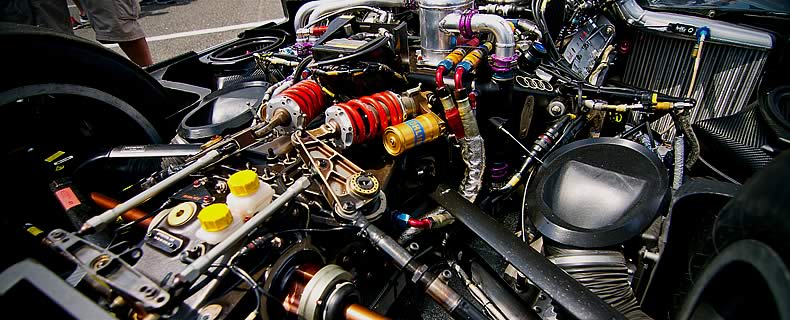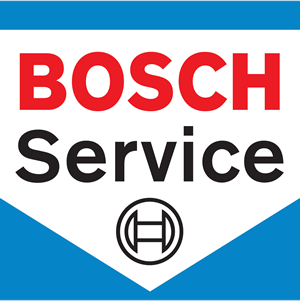
Suspension
Has your car been steering erratically lately? Have you noticed an unfamiliar "clunking" noise coming from under your car? Are your tires wearing unevenly? These symptoms can be the after-effects of hitting a pothole. Because of a record-breaking winter,road repair crews in many areas are behind in their work.
Hitting a pothole or rough railroad crossing can do more than jar your teeth,it can damage a tire or certain under-car parts. To minimize the jolt and potential damage, you should apply the brakes before you reach the obstruction, releasing the brake during the impact. If your foot remains on the brake, causing the wheel to slam into the pothole rather than to roll over it, damage may be aggravated.
A close inspection underneath the vehicle of tires and other
components after a serious altercation with a pothole, curb
or other obstruction.
Worn Parts Exaggerate the Problem
The effects of an impact with a rut, or series of ruts, are amplified when chassis parts are worn. Rubber bushings wear with time and mileage, as do the swivel joints that support and steer the car. Weak shock absorbers or struts, which help absorb the blow, cause a vehicle to be especially vulnerable to damage.
The life expectancy of steering and suspension components such as ball joints, tie rod ends and idler arms is shortened more by travel over rough roads than by long distance driving.
Never underestimate the value of a semi-annual alignment check along with tire rotations and balance. It can disclose an under-car problem that not only can save tire wear but also can affect driving safety. Remember,too,that your front wheel drive car may require four wheel alignment.
Shock absorbers and struts do
more than just provide a comfortable ride. Their most important
function is to influence the control and handling characteristics
of your vehicle. Without them, a vehicle would continually bounce
and bound down the road, making driving extremely difficult.
Shocks and struts are designed to help keep your tires on the
road. They control the action of the spring to resist bottoming
out . . . like when you hit a pothole . . . and keep the movement
of the springs under control when they rebound. Shocks provide resistance by forcing hydraulic fluid (oil)
through valves in the piston as it moves up and down. Because
the oil cannot be compressed, only a certain amount of fluid
can be forced through these valves, which creates resistance
to the vehicle movement. Premium shocks and struts are superior
to regular hydraulic shocks because air in the shock is replaced
by pressurized nitrogen gas. This advancement in technology
prevents bubbles from forming in the hydraulic fluid. These
bubbles, called foaming, reduces the ability of shocks to
provide resistance and prevent bounce. Gas shocks also quicken
the response of a shock's movement, thereby increasing comfort
and control under all conditions. Under normal conditions, shocks and struts wear out gradually.
However, many factors can affect how much wear is actually
occurring and at what rate it is occurring. For example,
two people buy the same vehicle new off the dealer lot .
. . one lives in the city close to the office, and drives
mostly on straight roads. The other lives in the country,
45 miles from the office and must travel 10 of those miles
on a winding, often muddy gravel road. Because shocks operate
in extremely hostile under-vehicle environment, where anything
from gravel to ice and snow to grit can affect the life of
the product, it is a good bet that driver #2 will need to
replace his shocks long before driver #1. The piston rod
can easily be nicked or damaged by flying gravel allowing
grit and dirt to damage the piston seal. When this occurs,
fluid begins to leak from the piston seal and eventually
the shock will lose its ability to function properly. Worn shocks and struts not only affect the ride comfort
and control of your vehicle, but can affect its braking effectiveness,
too. Here is a good self test to check for signs of worn shocks
or struts: Do you experience excessive bounce (3 or more bounces)
when crossing an intersection or dip? When stopping quickly, does your vehicle rock back and
forth several times? While applying your brakes firmly at higher speeds, does
your vehicle have a tendency to drift left or right? When changing lanes quickly does your vehicle rock or sway
from side to side? On a tight curve like a freeway ramp, does your vehicle
lean and sway giving it an uneasy and disconnected feeling? Many components contribute to the handling characteristics
of your vehicle. Having your vehicle inspected if you experience
any of the above signs is good preventive maintenance and
can help parts wear less and last longer. When inspecting
shocks and struts, your service technician will look for: 1. A badly leaking shock or strut: The unit is losing fluid
and can't provide the resistance for which it was originally
designed. Shiny Spots:
at the contact point of the safety bumper. and marks between
the coils of the spring called "coil
clash." They are the result of topping and bottoming
caused by excessive suspension travel. Tire cupping:
around the circumference of the tire can be caused by worn
or ineffective shocks & struts. Broken or loose shock or strut mount: The product is not
solidly connected at both ends and cannot function properly. Broken or damaged piston rod: The product cannot function
properly and should be replaced. So now that you've got the facts, wouldn't you agree that
shocks and struts provide more than just a comfortable ride? I'm sure you've probably heard this before. "Your shocks
and/or struts are blown and need replacing." Some astronomical
price is quoted and you immediately ask yourself, "How important
are these things -- do I really need to replace them?" These
are good questions that deserve attention. First of all, it is important to note that not all vehicles
have both shocks and struts. Some have just struts and some vehicles
have only shocks. Shocks are part of the overall suspension,
and a strut is a complete suspension assembly. The shocks and/or struts in your car perform
two functions. They dampen spring oscillation, and secondly,
they aid in ride
control. The springs in your car actually absorb road shocks
(not the shock absorbers). Surprised? The shock absorber's function
is to dampen the bouncing spring. If you did not have shock absorbers
to dampen the spring oscillations from road shock, your car would
turn into a "bucking bronco" every time you hit a bump
in the road, making it very difficult to handle and dangerous. The shock absorbers in your car aid in ride control by keeping
the car manageable during regular driving. They do this by keeping
the tires down on the road and not allowing them to bounce after
hitting a bump. This allows for ease of cornering and handling. The symptoms: * Vehicle rolls or sways on turns In addition, worn shocks and/or struts can accelerate the wear
of your tires and suspension parts -- the ball joints, steering
linkage, springs and C.V. joints. Preventative checkups are the key to side-stepping the effects
of worn shocks and/or struts. Have your technician check them
every time you have an oil change. Things to look for: * Leaks on the housing Don't "cut corners" when it comes to
shocks and struts. Proper functioning of these parts is essential
to the handling
and cornering of your vehicle, making for safer driving conditions.
How Shocks And Struts Work
How to Tell if Shocks and Struts Need Replacement
2.
3.
4.
5.
* Front end dives when braking
* Rear end squats when accelerating
* Vehicle bounces or slides sideways on a winding, rough road
* Vehicle "bottoms out" (with a thump) on bumps
* Dents on the shock or strut body
* Worn rubber mounting bushings
* Pitted piston rods
* Crushed rubber bumpers from "bottoming out"
* Abnormal wear on tires (high and low spots)






